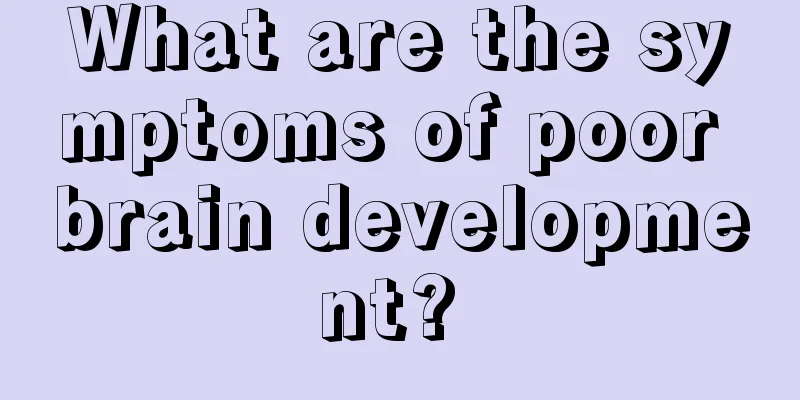What are the symptoms of poor brain development?

|
If the brain does not develop well, it is easy to show intellectual disabilities or perceptual disorders. In addition, children's poor brain development will be affected by many factors, and may also show growth and development disorders, movement disorders and other symptoms. 1. Intellectual disabilities and perceptual disorders: Among all children with brain dysplasia, about 1/4 have normal intelligence, about 1/2 have mild or moderate intellectual disabilities, and about 1/4 have severe intellectual disabilities. Perceptual disorders: Most patients are allergic or unresponsive to stimuli; some experience fixed perception, disordered background and graphics. 2. Visual and hearing impairment: Many children with brain dysplasia have myopia or strabismus, among which esotropia is the most common. Hearing loss is more common in athetoid cerebral dysplasia. Children with poor brain development often have difficulty distinguishing the rhythm of sounds. 3. Growth and development disorders: Some children with mild cerebral dysplasia may have basically or nearly normal growth and development, but most children with cerebral dysplasia are shorter than normal children of the same age and their growth and development appear to be lagging behind. 4. Language disorders: Most children with cerebral dysplasia may have causes of cerebral dysplasia. 1. Harmful factors 5. Postural disorders: Children with cerebral dysplasia have abnormal body postures, poor posture stability, awkward postures when exercising or at rest, and asymmetry between the left and right sides. In some severe cases, the head is often not in an upright central position like that of normal children, but tends to lean to one side, or sway left and right, front and back. 6. Epilepsy: About 39%-50% of children with cerebral dysplasia suffer from epilepsy due to fixed lesions in the brain. The incidence of epilepsy is particularly high in children with severe intellectual disability. 7. Movement disorders: Children with cerebral dysplasia have lower motor skills than normal children of the same age and poor motor self-control. In mild cases, the hands and feet are only slightly inflexible or clumsy. In severe cases, the hands cannot grasp things, the feet cannot walk, and some cannot even turn over, sit up, stand, chew and swallow normally. 8. Frequent abnormal performance: Children with cerebral dysplasia have delayed development in intelligence and other related aspects, so they have difficulty concentrating, have fewer conscious reactions to their own behavior, and cannot remember people. In daily life, they tend to be relatively quiet and docile, lacking the vitality typical of children, and will not actively respond to the outside world. They lack interest in the outside world and sometimes show excessive crying and laughing. Children with severe brain dysplasia may even suffer from incontinence, aphasia, and sometimes epilepsy. |
<<: How to effectively restore myopic astigmatism?
>>: Can I eat peanuts if I often have high blood sugar?
Recommend
What should I do if I keep coughing up phlegm after radiotherapy for nasopharyngeal carcinoma? Is it serious?
Everyone knows that radiotherapy has great side e...
What may be the causes of pinky joint pain?
The fingers are connected to the heart. If the li...
The difference between spine and cervical vertebra
Many people think that the spine and cervical ver...
There are several varieties of sweet potatoes
Sweet potatoes have always been everyone's fa...
TCM Syndrome Differentiation and Treatment of Gallbladder Cancer Jaundice
As the disease progresses, patients with gallblad...
What are the causes of atherosclerosis
As people pay more and more attention to diseases...
So what should people with colon cancer avoid eating? What are the precautions?
In recent years, colon cancer has gradually risen...
Artificial urticaria treatment remedy, simple and effective!
Urticaria can be divided into many types, some ar...
Improper treatment of lymphoma can cause great harm
If lymphoma is not treated carefully, it can caus...
What are the symptoms of prostate cancer in the early stages?
Cancer is the biggest culprit affecting human hea...
What are the chemotherapy drugs used in clinical treatment of lung cancer
Chemotherapy is one of the three main methods for...
What are the types of bone cancer
What are the types of bone cancer? In recent year...
What to do if white shoes rub the heels
Nowadays, white sneakers can be said to be the ne...
Is cystoscopy reliable for kidney cancer?
Cystoscopy for kidney cancer: In our daily life, ...
What kind of water is good for making compressed facial mask
The characteristics of compressed facial masks ar...









